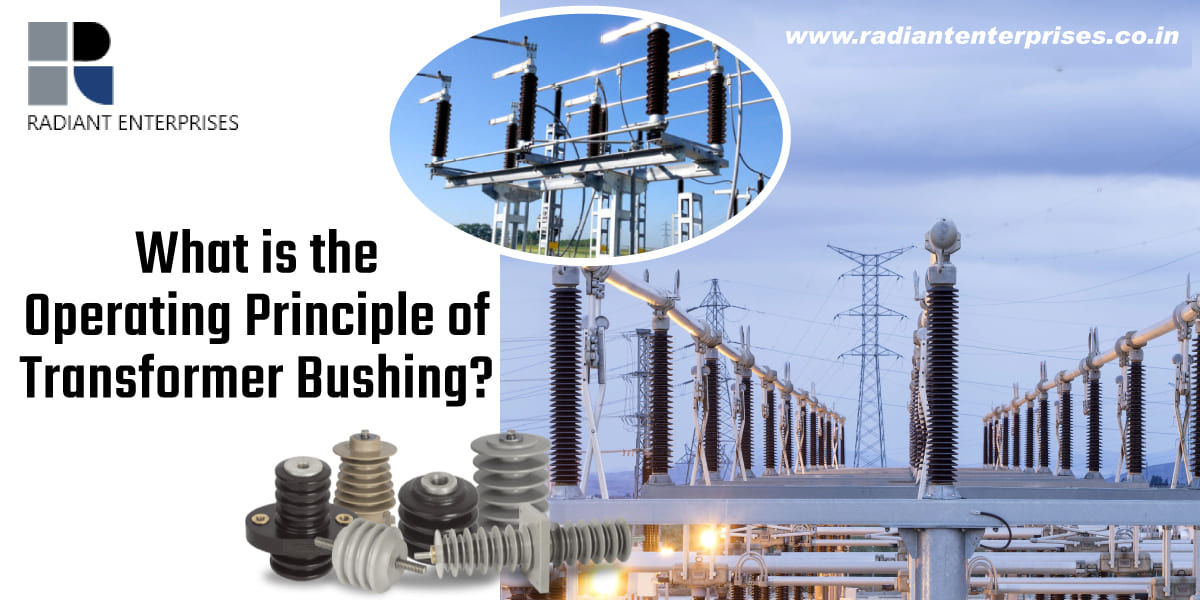
Fill all information details to consult with us to get services from us

A transformer bushing is an insulating device that allows an energised, current-carrying conductor to pass through the transformer's grounded tank. A bottom-connected bushing may have the conductor built into it, or a draw-lead or draw-rod bushing may have a separate conductor dragged through its centre.
Solid or bulk type bushings and capacitance-graded bushings are the two main forms of bushing construction (sometimes called condenser type). Solid type bushings with porcelain or epoxy insulator are commonly utilised for a transformer's low voltage winding(s). The high voltage winding of a transformer is made up of capacitance-graded bushings that are suited for higher voltage ratings.
Radiant Enterprises is an excellent transformer bushings Manufacturer In India.
The bushing is an insulated device used in electric power that allows an electrical conductor to safely pass through grounded conducting obstacles such as those found in transformers and circuit breakers.
Radiant Enterprises ranks high among the top transformer bushing manufacturer in USA.
Because all of the transformer's windings are connected to high voltage lines, the transformer's end connection must be carefully inspected to minimise flashover from the high voltage connection contact with the transformer's body. For low voltage distribution transformers, cable connections are made in cable boxes on the secondary side, while for power transformers, both sides of the transformer will be in high voltage. Because we require a specially built equipment known as bushings.
Bushings are made up of the current-carrying section of a conducting rod in the centre, a bus or cable, and a porcelain cylinder that is inserted into a hole in a transformer cover and used to isolate the current-carrying component.
A moulded, high-quality glazed porcelain insulator with a via conductor at its centre is the most basic bushing. This bushing has a smooth or slightly finned surface and is suitable for voltages up to 33 kV inside. Petticoats are used on the outside (top section) of transformer bushings that work outdoors to protect the bottom fins from water in wet weather.
If you are looking for the best quality transformer bushing manufacturer in Mexico, Radiant Enterprises is the right choice for you.
Oil-filled or capacitor-type bushings are utilised in transformers with voltages greater than 36 KV. A hollow two-part porcelain cylinder with a conductor, usually a cylinder, travelling through its axis makes up the oil-filled bushing. Oil is poured into the area between the conductor and the porcelain's inner surface. The oil in the transformer tank is kept separate from the oil in the transformer tank. A tiny expansion chamber is linked to the top of the bushing to allow fluctuations in the volume of the oil temperature. At the lower end of the bushing, there is a place for the current transformer
Radiant Enterprises is one of the most popular and distinguished transformer bushing Suppliers in Europe.
The configuration allows the bushing to be removed without causing any damage to the current transformer. Layers of Synthetic Resin Bonded Paper (S.R.B.P.) are interleaved with thin layers of metal foil for paper impregnated with conducting substance to make the capacitor bushing. As a result, a series of capacitors are created, each of which is made up of two layers of metal foil with S.R.B.P. The cylinder in the middle. The lengths of metal foils and the thickness of the S.R.B.P. cylinder are placed in such a way that dielectric stress is distributed uniformly across the radial depth, i.e. throughout the radius of the bushing.